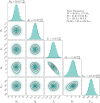A warm Neptune's methane reveals core mass and vigorous atmospheric mixing
- PMID: 38768633
- PMCID: PMC11208151
- DOI: 10.1038/s41586-024-07395-z
A warm Neptune's methane reveals core mass and vigorous atmospheric mixing
Abstract
Observations of transiting gas giant exoplanets have revealed a pervasive depletion of methane1-4, which has only recently been identified atmospherically5,6. The depletion is thought to be maintained by disequilibrium processes such as photochemistry or mixing from a hotter interior7-9. However, the interiors are largely unconstrained along with the vertical mixing strength and only upper limits on the CH4 depletion have been available. The warm Neptune WASP-107b stands out among exoplanets with an unusually low density, reported low core mass10, and temperatures amenable to CH4, though previous observations have yet to find the molecule2,4. Here we present a JWST-NIRSpec transmission spectrum of WASP-107b that shows features from both SO2 and CH4 along with H2O, CO2, and CO. We detect methane with 4.2σ significance at an abundance of 1.0 ± 0.5 ppm, which is depleted by 3 orders of magnitude relative to equilibrium expectations. Our results are highly constraining for the atmosphere and interior, which indicate the envelope has a super-solar metallicity of 43 ± 8 × solar, a hot interior with an intrinsic temperature of Tint = 460 ± 40 K, and vigorous vertical mixing which depletes CH4 with a diffusion coefficient of Kzz = 1011.6±0.1 cm2 s-1. Photochemistry has a negligible effect on the CH4 abundance but is needed to account for the SO2. We infer a core mass of , which is much higher than previous upper limits10, releasing a tension with core-accretion models11.
© 2024. The Author(s).
Conflict of interest statement
The authors declare no competing interests.
Figures











References
-
- Stevenson KB, et al. Possible thermochemical disequilibrium in the atmosphere of the exoplanet GJ 436b. Nature. 2010;464:1161–1164. - PubMed
-
- Kreidberg L, Line MR, Thorngren D, Morley CV, Stevenson KB. Water, high-altitude condensates, and possible methane depletion in the atmosphere of the warm super-Neptune WASP-107b. Astrophys. J. Lett. 2018;858:L6.
-
- Fu G, et al. Water and an escaping helium tail detected in the hazy and methane-depleted atmosphere of HAT-P-18b from JWST NIRISS/SOSS. Astrophys. J. Lett. 2022;940:L35.
-
- Dyrek A, et al. SO2, silicate clouds, but no CH4 detected in a warm Neptune. Nature. 2024;625:51–54. - PubMed
-
- Bell TJ, et al. Methane throughout the atmosphere of the warm exoplanet WASP-80b. Nature. 2023;623:709–712. - PubMed

